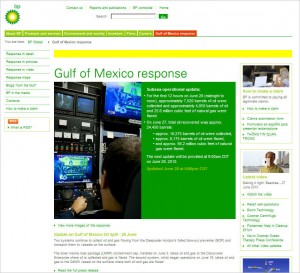The standout story of June was British Petroleum’s handling of the Deepwater Horizon oil spill. “Careers” Meets Crisis, posted at the beginning of June, noted that BP’s Careers page remained unchanged more than a month after the crisis began. Not only was there no mention of the spill, the “Featured job category” highlight extolled opportunities in the Gulf of Mexico.
A month later, the featured job category is IT. But nothing else on the page has been added or updated to address the ongoing Gulf crisis. Similarly, nothing has been added or updated since the spill on BP’s Environment and Society page—which seems like an even bigger disconnect.
However, a few changes have been made to the corporate site.
- The Gulf Response tab, which was put in place soon after the crisis began, is now more tightly organized, focusing on technical and practical issues. The level of detail on this page conveys much more effectively the seriousness of BP’s efforts.
- Some of the content originally shown on the Gulf Response tab is now on the landing page—so users who navigate directly to the site by typing www.bp.com into their browsers (or clicking on a sponsored link) will see Gulf-related material immediately. The page begins with a large photo feature that depicts people at work: cleaning sand, pointing at maps, rescuing birds, etc.
- Also on the BP landing page: videos about the company’s good intentions and positive efforts, along with information links (both contact information and news stories). Overall, the page has a slightly positive spin, but not a pronounced “PR” flavor.
- On the Investors page, a headline feature leads readers to the “Chairman’s letter to shareholders.” That’s the only reference.
In reality, people looking for information on the Gulf spill don’t make a beeline for the BP site. Traffic statistics show that the majority of searchers proceed to stories from the Huffington Post, the New York Times, or other news sources. But people looking for a job at BP are very likely to go to the corporate site—and the impression created there will matter to some job-seekers.
BP has made some moves into social media in the meantime, with a decent Twitter performance, a YouTube channel, and a Facebook page. However their YouTube effort drew criticism because comments were not allowed for the first few weeks, and on Facebook comments are only allowed from those who have “Liked” BP. These policies don’t seem to improve impressions of the company . . . .
A hat-tip to Fran Melmed, whose comment on our original story included the idea that BP could feature positive comments and stories from Gulf Coast employees on their Careers page. (Fran tuned in to the BP/Careers story early with a hard-hitting post on her blog.)
Lucy is Editor at Corporate Eye

thanks for the hat tip!
interestingly, BP “gets it” with other external channels. there were some terrific ads (i saw them in the new york times) featuring employee profiles. though they were designed to address public anger, they also presented a different BP face, one of compassion, intelligence, and hard work. i’m surprised they’re not using these on their own site.
f